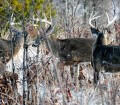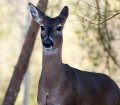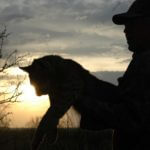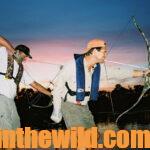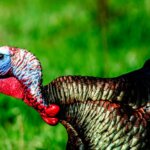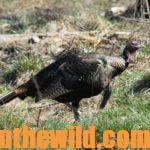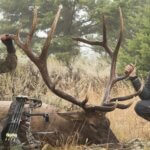John’s Note: Successful bass fishermen study bass and learn their patterns. Once you learn to identify and read buck sign, you can match your tactics to what the deer are actually doing – instead of what you hope they’re doing.
The air was cold, and the wind was blowing when I got up the following morning to go out to hunt (see Days 1 & 2). As I walked to the creek, I was concerned about the wind’s direction. When I arrived at my stand, I realized the wind was carrying my scent down the creek into the area where the big buck had been seen. Although I waited for 15 minutes, hoping that the wind either would die or change direction, the wind continued to blow. I knew that all my chances for taking the big buck that day were gone, since my number-one hunting spot was eliminated because of unfavorable wind conditions.
Quickly I went to the funnel area to take a stand before daylight. But 1-1/2-hours after daylight, I still hadn’t seen or heard anything. There were no well-defined trails through the funnel region, and I had seen very-few droppings. If I had sat in this spot all day long, I might have seen a deer. But in an area that should be red hot and knowing that I didn’t have long to hunt, I decided to exercise my third option – the hardwood flats where I had observed signs of deer feeding. On the way to the feeding area, I once again checked the scrapes along the road. They still had leaves in them and had not been pawed-up the previous night. So, I eliminated this place. If I had found fresh signs in the scrapes, I would have stayed there and hunted. But since there had been no fresh signs for 2 days, I continued to move toward the acorn flats.
 As I approached the feeding area I decided that the best place to take a buck would be about one fourth of the way into the feeding area. Then I could see the thickets on the left-hand side of the hardwoods and all the way through the bottom, which was about 250-yards long and about 75- to 100-yards wide. But I made a fatal mistake. Finding deer does not equal taking deer. Instead of using my binoculars to glass the area before I started into it, I began to slowly stalk toward the large beech tree where I would take my stand. But 20 yards into the bottom, I heard a rustling in the leaves and saw the white flags of fleeing deer. I watched down the woods road as a high-racked buck darted across the opening. Quickly I brought my rifle to my shoulder and spotted the deer through my scope.
As I approached the feeding area I decided that the best place to take a buck would be about one fourth of the way into the feeding area. Then I could see the thickets on the left-hand side of the hardwoods and all the way through the bottom, which was about 250-yards long and about 75- to 100-yards wide. But I made a fatal mistake. Finding deer does not equal taking deer. Instead of using my binoculars to glass the area before I started into it, I began to slowly stalk toward the large beech tree where I would take my stand. But 20 yards into the bottom, I heard a rustling in the leaves and saw the white flags of fleeing deer. I watched down the woods road as a high-racked buck darted across the opening. Quickly I brought my rifle to my shoulder and spotted the deer through my scope.
A big doe stopped on the edge of the road and looked directly at me. At 200 yards, the animal was too small in the scope at 2X. So, I very slowly and carefully twisted the end of my scope until the deer grew much larger when the scope was at its maximum X. But even though the deer was larger in the scope, holding a rifle on target at 200 yards when you are wearing a bulky snowmobile suite is quite a task. I couldn’t get the crosshairs to settle on the deer’s shoulder. Therefore I knew if I was going to take the doe, I either would have to brace against the tree or try and get to a sitting position without the deer’s seeing me. The doe turned her head and started to walk off, and I sat down and took aim. However, since from the rear the deer presented an even smaller target, I turned down the shot.
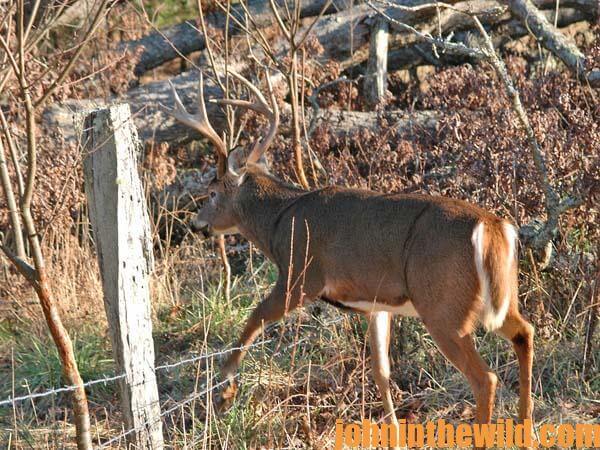 “I should have shot when I was standing,” I told myself. “I might have been able to make that shot. But I never will know, since I didn’t try. Oh well, the deer is gone, the shot is gone, and the opportunity to take meat home is gone. But at least I’ve been successful in finding deer through eliminating all the other areas. If I get to that big beech tree and take a stand, some more deer may come through here.”
“I should have shot when I was standing,” I told myself. “I might have been able to make that shot. But I never will know, since I didn’t try. Oh well, the deer is gone, the shot is gone, and the opportunity to take meat home is gone. But at least I’ve been successful in finding deer through eliminating all the other areas. If I get to that big beech tree and take a stand, some more deer may come through here.”
I stood up, took six more steps, heard another rustling in the leaves and saw a white flag. This time I was ready. I got my rifle up and waited for the deer to cross the road in front of me. But instead of crossing the road, the buck stopped on the edge of the road at 150 yards and turned broadside. Once again I was caught standing in an awkward position, but this time with the deer looking at me and swishing his tail. I knew he was going to break and run. So, I fired quickly and completely missed him. The deer didn’t drop his tail like a wounded animal and didn’t run like a scalded dog. He simply threw his tail up and bounded away – waving a goodbye with his white flag.
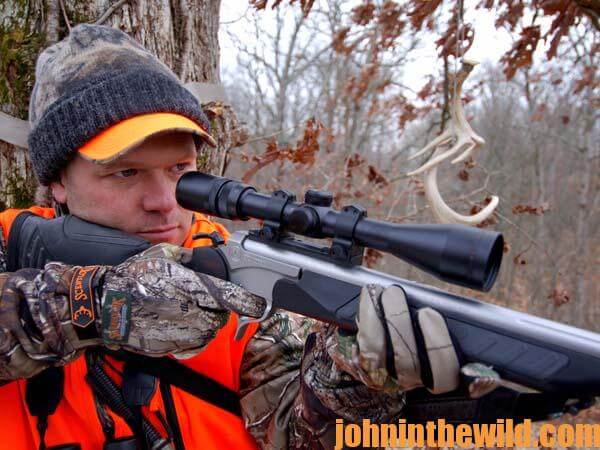 I had seen two big bucks and a doe and had a shot. Some might say that my hunt was unsuccessful. But I believe that just the opposite was true. I learned how to find deer by patterning them like bass fishermen do. Before you can begin to decide how to take a deer, you have to locate that deer first. By eliminating hunting areas, I had put myself in the very best position to see deer, and you can too.
I had seen two big bucks and a doe and had a shot. Some might say that my hunt was unsuccessful. But I believe that just the opposite was true. I learned how to find deer by patterning them like bass fishermen do. Before you can begin to decide how to take a deer, you have to locate that deer first. By eliminating hunting areas, I had put myself in the very best position to see deer, and you can too.
To get John E. Phillips’ Kindle eBooks and print books on hunting deer, “How to Hunt and Take Big Buck Deer on Small Properties,” “How to Hunt Deer Up Close: With Bows, Rifles, Muzzleloaders and Crossbows,” “PhD Whitetails: How to Hunt and Take the Smartest Deer on Any Property,” “How to Take Monster Bucks,” “How to Hunt Deer Like a Pro,” and “Bowhunting Deer: Mossy Oak Pros Know Bucks and Bows,” or to prepare venison, “Deer & Fixings,” click here.
For information on making jerky from your deer to provide a protein-rich snack, you can download a free book from https://johninthewild.com/free-books.

